
How to Make Writing Fun for Elementary Students: The Ultimate Guide
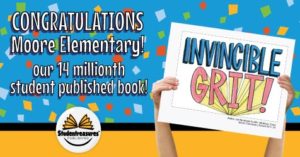
Some days, your students’ eyes sparkle as they become engrossed in their classwork. Other days, it’s a challenge just to get them to focus on an assignment. Ms. Osborne, Ms. Owen and Ms. Sedillo have discovered a way to capture their students’ imaginations while teaching valuable lessons about writing, collaboration, and diligence. In fact, their 4th, 2nd, and kindergarten classes at Moore Elementary School were among the lucky few who got to celebrate the 14 Millionth Book published by Studentreasures, Invincible Grit by Mrs. Medders’ 1st-grade class. After the festivities, they shared a few lessons they learned from their classbook projects about how to make writing fun for elementary students.
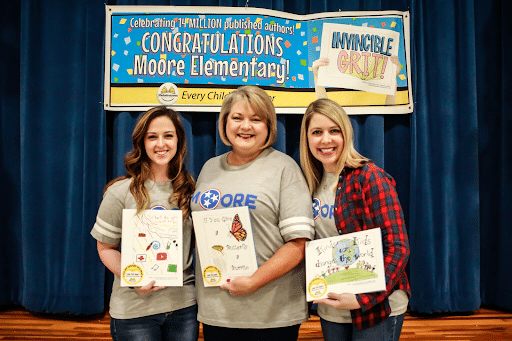
Ms. Osborne, Ms. Owen and Ms. Sedillo show off their students’ published works.
Lesson 1: Plan, But Be Flexible
It’s important to always leave room in your schedule for unexpected delays and detours, especially if the assignment you have in mind is more in-depth or explores multiple stages of the writing process. As Ms. Owen emphasizes, “Plan, plan, plan, plan, plan! However, be flexible. These are children. They’re gonna make mistakes . . . you don’t always know where your story is going to lead you. Especially if you’re writing a fiction piece.”
“And give it time,” adds Ms. Osborne. “Especially because it’s a writing process. . . . It’s just different for everybody.”
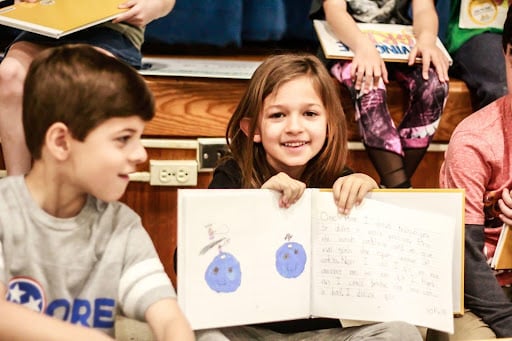
One #proudauthor happily displays her work.
Allotting too little time to an assignment is stressful, both for you and for your elementary students. Feeling rushed or pressured can paint your kids into a corner and stifle their creative freedom. Be sure to give their imaginations time and space to explore, and give your students the green light to make (and learn from) mistakes.
Lesson 2: Make it a Team Effort
While we often think of writing as a solitary endeavor, creating a collaborative work can be as enjoyable for writers as it often is for readers—especially when your authors are young elementary students who love nothing more than to have fun with their friends. Working together also helps build a sense of support and community among your class as your students forge stronger connections with one another and learn to work harmoniously in teams.
According to Ms. Owen, “What my students and I got out of this . . . was just one more tool I could use to encourage, model and teach collaboration. It took a lot of collaboration to do, particularly our book, because it was a sequence type of thing. So we had to make sure that what was before our page made sense in leading into the next page. I had a couple students even collaborate on a particular illustration in the book.”
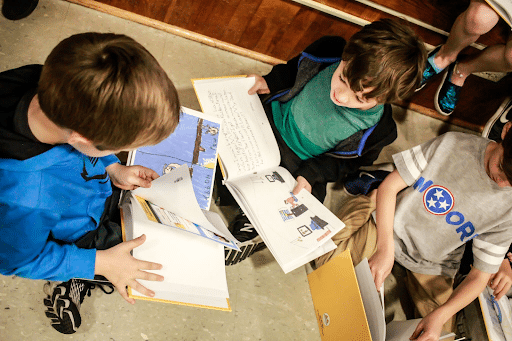
These #proudauthors enjoy reading their book almost as much as they enjoyed making it together!
It’s also fun to watch, at least in Ms. Sedillo’s experience. “They came up with the design [for the book], and it was the sweetest thing,” she says. Her students decided that each of them should get a chance to make their mark on the cover and title pages of their book, and divided up the work so that everybody got a chance to draw or color something on each page. “It was so sweet, because every single person in the class touched the cover page and the title page. . . . So every single person had that little piece of it.”
Lesson 3: Entertain, Engage, and Encourage
In addition to flexible plans and peer support, making the writing process fun for your elementary students requires the three “E”s: entertainment, engagement, and encouragement.
- Keep your students entertained by choosing the right subject matter. Avoid boredom by identifying a prompt that speaks to their experiences and their interests. Try open-ended questions that allow for a variety of interpretations and responses. You can even draw inspiration from other lesson plans already in place, as long as you can identify an angle which will really spark their curiosity.
Ms. Sedillo’s class got the idea for their book, Kinder Kids Can Change the World, while learning about Martin Luther King, Jr., while Ms. Osborne’s class came up with What Do You Want to Be When You Grow Up? while researching inspirational figures like Abraham Lincoln and Nellie Bly. Meanwhile, Ms. Owen’s class paid tribute to one of their favorite Laura Numeroff books with the comically titled, If You Give a Butterfly a Burrito.
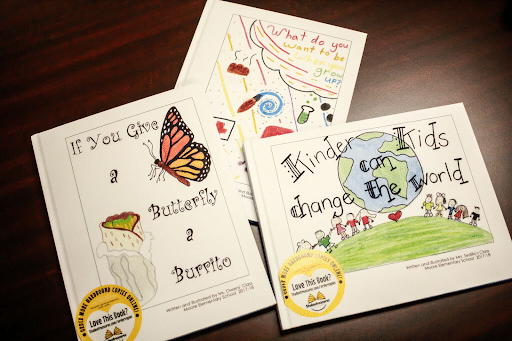
Three beautiful books published by three talented classes full of #proudauthors.
- Keep your students engaged in the writing process by welcoming their input. Even shy kids have very strong opinions about just about everything. Let them know that you value these opinions by inviting them to share and help shape the course of their assignments and projects. “[My students] enjoyed that it was something that they got to choose to write about, instead of me telling them what we had to write about,” says Ms. Osborne. “That choice makes a difference.”You might even be pleasantly surprised at what your students come up with. Ms. Owens’s class, for example, realized early on that the original title of their book just didn’t quite have the right ring to it. “We talked about If You Give a Butterfly a Taco, and the kids said, ‘No, a burrito! That’s alliteration, Ms. Owens!’” Ms. Osborne even worked with her students to brainstorm potential topics while browsing classbook examples on the Studentreasures website, ultimately letting her class vote on which idea they liked best.
- Most of all, be sure to regularly encourage your students to believe in themselves and their writing. It’s hard to have fun when you’re feeling self-conscious or fretting about making a mistake. Keep them motivated by keeping them inspired.For Ms. Sedillo, a key aspect of this was showing her students what they had to look forward to by sharing the classbook she’d helped a previous class publish. “They were so excited, they just couldn’t believe that theirs was going to be a real book that they could check out in the library or take home. That part, they were just blown away by.”
#Proudauthors Evan, Riley and Sawyer discuss the 14 Millionth classbook, Invincible Grit.
Lesson 4: Don’t Forget to Celebrate!
Last but certainly not least, the most fun part of the publishing process is the launch party! A celebration is the perfect way to honor your students’ hard work and give them a chance to process their achievement.
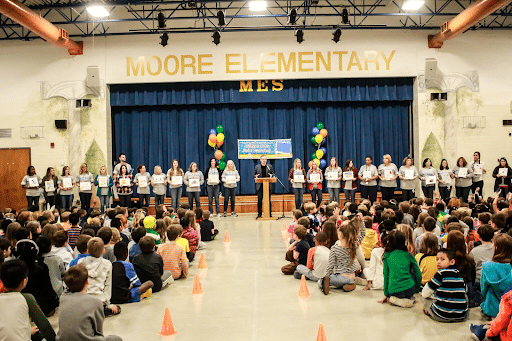 The #proudauthors of Moore Elementary celebrate their new books in a big way.
The #proudauthors of Moore Elementary celebrate their new books in a big way.
Keep in mind that a celebration doesn’t have to be a big publishing party or a fancy ceremony like the 14 Million Authors commemoration—particularly if the assignment in question is on a smaller scale. While parties can be as fun to plan as they are to enjoy, a simpler but still fun alternative is to simply gather together to discuss the writing assignment as a class and share final drafts.
In fact, for Ms. Sedillo, this was her favorite part of the entire writing process. “We sat down on the rug and I was like, ‘Okay, we’re ready to share our classbook!’ And their eyes were just ready to pop out. We worked on it for several weeks, and to see how hard all of their friends had worked on that final draft copy before it went to print was just so exciting.”
For Ms. Osborne, simply seeing how passionate her students were about their project was worth celebrating. “I think my favorite part was just talking to them about something that inspired them or that they’re thinking about, and having a connection outside of just the academic part. . . . Their eyes lighting up when they’re telling me all their plans and dreams, and talking about how they can get there and making the goals—to me, that’s my favorite part.”
How Publishing Augments the Fun of Writing
While any writing assignment can spark joy in your young authors, a larger project like publishing a classbook is the ideal way to highlight the real fun of writing. A classbook project allows your students the time and mental space to do what they do best—play. Instead of toys, they get to play with words, images and all those great ideas they have bouncing around in their heads.
Becoming published authors is more than fun for your students—it’s inspiring. Ms. Osborne’s students didn’t just pick their dream jobs out of thin air, they planned for how to pursue their passions and make those dreams come true. Ms. Owens’ students felt really good about themselves when the book arrived, giving them a sense of a job well done. She attributes her students’ newfound confidence in themselves and their writing to seeing their work professionally bound and printed. And for Ms. Sedillo, the experience of publishing her students’ writing was as significant to her as it was to her students:
“To ingrain in them that they are authors and they are writers and the value of written work, I think that is very special too. It’s such a big deal to us that we do spend the time on that, we are going to bind and save these samples of written work, because written work has value . . . That was important to me.”
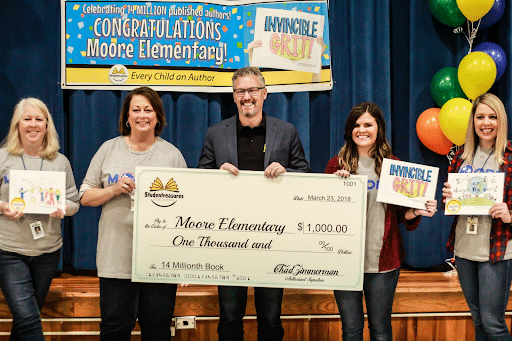
The teachers of Moore Elementary’s newly published authors proudly accept the 14 Million Authors award on behalf of their school.
For more fun teaching resources—including lesson plans, project ideas and more—be sure to visit our online teacher’s lounge and, of course, don’t forget to sign up for your free publishing kit!
Our Story
We provide teachers and schools with a FREE hands-on writing activity that motivates students to write and inspires students to learn by turning their stories into professionally bound books.
Learn More





